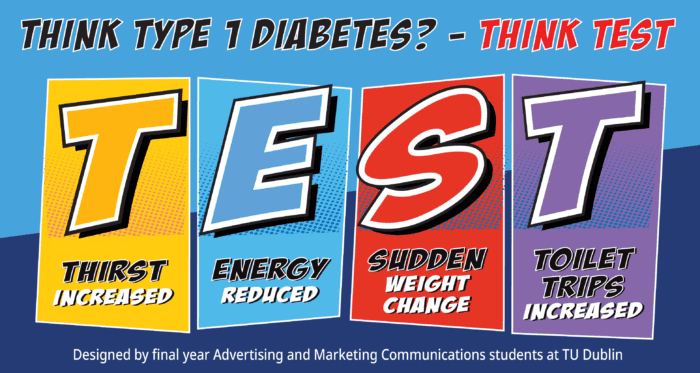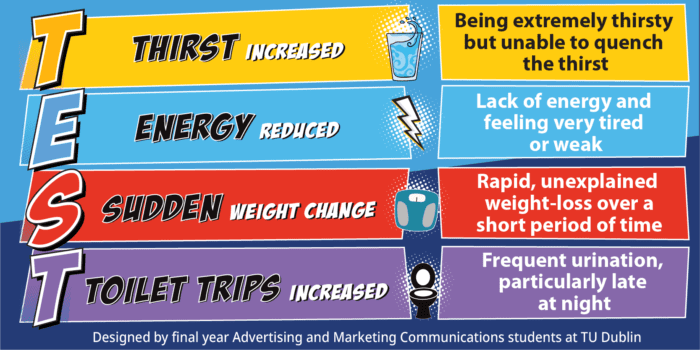Late August means school-time for parents, children, and teachers alike. The task of preparing for Back-to-School is busy and sometimes stressful for all, but it also provides unique excitement of reuniting with old friends and teachers or begin a new adventure in a new school. As the schools are about to be back, it is a perfect time to acknowledge that school staff provide an extremely important set of eyes for pupils. Some teachers spend so much time with them – they see pupils throughout the day and can notice when things are different, off, or just not quite right. They can often uncover important insights or issues. Knowing that children are well-cared is very comforting to all the families.
Know what it stands for
One of the conditions that teachers and Special Needs Assistants (SNAs) can often see signs of in the classroom is TYPE 1 DIABETES – one of the most prevalent chronic conditions in children and adolescents. The sooner the symptoms of diabetes are recognised, the lower risk of complications – therefore it is extremely important to know what to look for and TEST.
The TEST campaign was recently launched to raise the awareness of the symptoms of Type 1 diabetes. We believe that this simple acronym will help school staff, parents, grandparents, and all other members of the public to more easily remember and recognise them and take action.
Recognise the symptoms of Type 1 diabetes
TEST represents the following: Thirst (increased), Energy (reduced), Sudden (weight change) and Toilet (trips increased). These symptoms are key indications that a child might have Type 1 diabetes and a simple fingerprick blood glucose test is required urgently. Moreover, these symptoms are the same for adults – and not everyone is aware that Type 1 diabetes can be diagnosed at any age.
Professor Edna Roche, University of Dublin, Trinity College and Consultant Paediatric Endocrinologist, CHI at Tallaght University Hospital developed, and leads the Irish Childhood Diabetes National Register (ICDNR): “We all need to know the symptoms of Type 1 diabetes so we can recognise them early and take action. These TEST symptoms are the key indicators a child might have Type 1 diabetes. As schools reopen, we are asking all school staff to know the symptoms, look out for them during school time and don’t hesitate to speak to parents about any concerns you may have. Delays in diagnosis can happen because the symptoms of Type 1 diabetes are subtle, and we need to act quickly.
The sooner we act, the better – a delay in the diagnosis of Type 1 diabetes can quickly lead to a life-threatening complication called Diabetic Ketoacidosis (DKA). On average, 25 children are diagnosed with Type 1 diabetes in Ireland each month. In 2020, over 40% of new admissions with diabetes had DKA. This is an increase from 31.6% % in the period 2011-2015 and has increased steadily from 2016.
Professor Hilary Hoey, Chairperson of Diabetes Ireland said: “Delays in the diagnosis of Type 1 diabetes is an ongoing problem in Ireland, and COVID-19 pandemic made it even worse. Acting fast is so important and has great benefits – early recognition of symptoms will enable earlier diagnosis and treatment, preventing the development of DKA. Avoiding DKA can make the initial treatment much easier for children and their families and has short- and long-term benefits”.
Take action
What action to take when you recognize the symptoms? Share your thoughts and observations with parents/carers as soon as you have noticed them. A simple finger-prick blood glucose test (by a GP or Pharmacist) can inform whether a child/adult with the TEST symptoms needs to be seen by an emergency or diabetes team immediately. TEST is the key to diagnose Type 1 diabetes and lower the risk and prevalence of DKA.
And if the onset of Type 1 diabetes is confirmed? Don’t worry, you are not alone! 85% of almost 3.000 children and adolescents with diabetes are returning to schools this week! Therefore, we prepared tips, information, and guidance on how to take care of a pupil with diabetes at school – check the advice for teachers, SNA’s and parents on our website here: Heading back to School – Diabetes Ireland : Diabetes Ireland
Further information is available on www.diabetes.ie. The campaign is supported by the Irish Childhood Diabetes National Register (ICDNR), Diabetes Ireland and Novo Nordisk Ltd.



